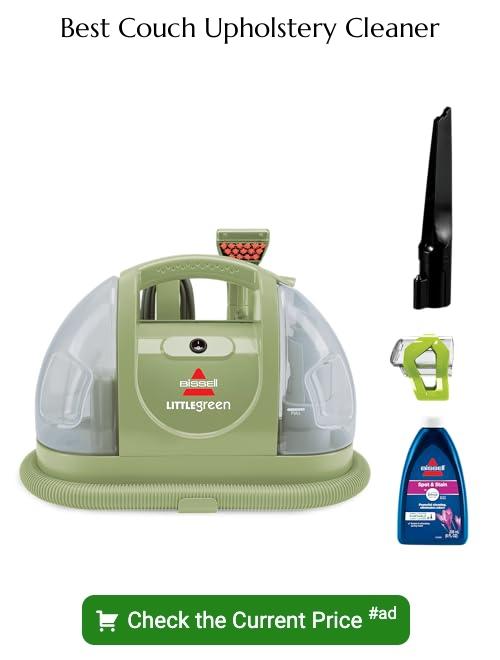Last updated on
Discover the effective method for cleaning your non-removable couch cushions, ensuring a fresh and cozy space in no time.
Couch cushions are an essential part of any living room, providing a comfortable place to sit and relax. However, they can also be a magnet for dirt, dust, and spills.
If you have couch cushions that don’t come off, cleaning them can seem like a daunting task. But fear not! In this article, we’ll show you how to wash your couch cushions effectively without having to remove them.
So grab your cleaning supplies and let’s get started!
Table of Contents
Before You Begin
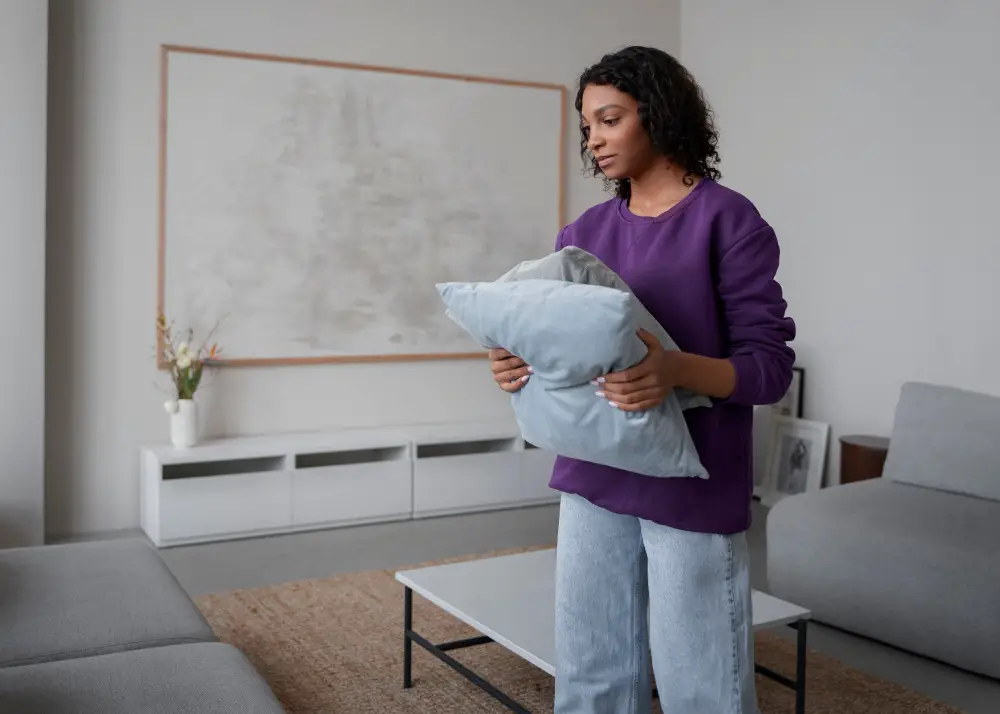
Before you begin cleaning your non-removable couch cushions, it’s important to prepare yourself and the area. Start by removing any loose items from the couch, such as pillows or throws.
This will give you more space to work with and prevent them from getting in the way during cleaning.
Next, put on a pair of rubber gloves to protect your hands while handling any potentially dirty or stained areas. You may also want to wear old clothes that you don’t mind getting wet or dirty.
It’s also essential that you have all necessary cleaning supplies ready before starting. Depending on what materials your cushions are made of and how soiled they are, different products may be required for optimal results.
Read the Care Instructions

These instructions can usually be found on a tag attached to the cushion or on the manufacturer’s website. It’s important to follow these guidelines carefully, as some materials may require special treatment or could be damaged by certain cleaning products.
For example, if your cushions are made of delicate fabrics like silk or velvet, you may need to use a gentler cleaning method than if they were made of more durable materials like polyester or cotton. Some types of stains may require specific treatments that are not suitable for all fabrics.
Identify Cushion Materials
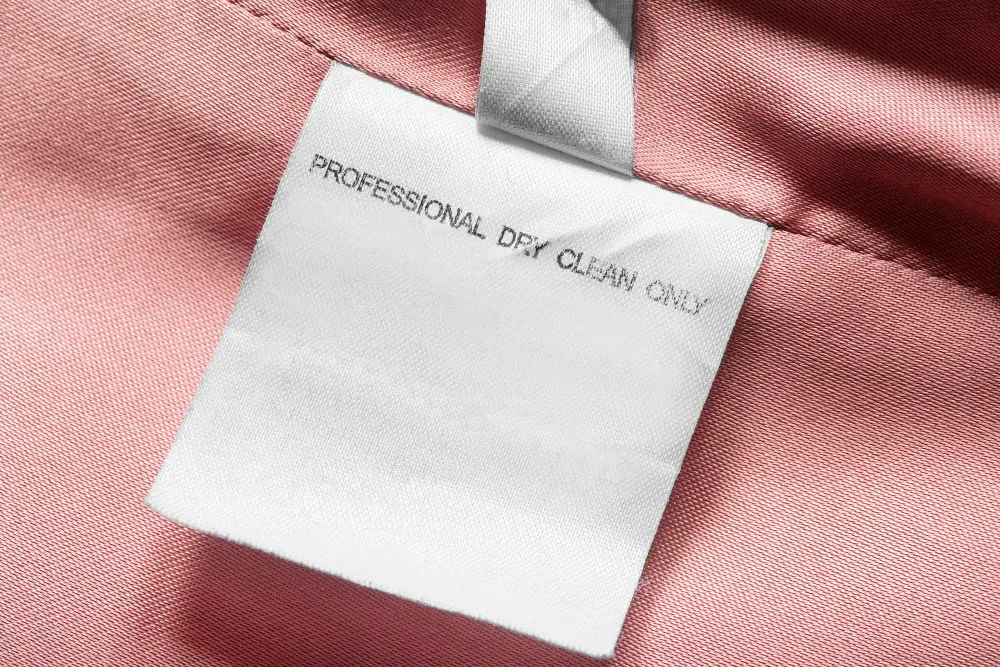
This will help you determine the best cleaning method and avoid any damage to your cushions.
Most couch cushions are filled with foam, feathers, or a combination of both. Foam-filled cushions can be cleaned using water-based solutions, while feather-filled ones require dry-cleaning methods.
To identify what type of cushion filling you have, unzip a small section on the underside of one cushion and take a peek inside. If it’s filled with foam pieces or shredded foam material that sticks together when compressed, then it’s likely made from polyurethane foam.
On the other hand, if there are feathers visible inside or down clusters that fluff up when squeezed gently between fingers – then this indicates feather fillings.
Vacuuming Your Couch Cushions

This will help remove any loose dirt, dust, and debris that may have accumulated on the surface of the cushions. To do this effectively, use a handheld vacuum or an upholstery attachment on your regular vacuum cleaner.
Start by removing any large particles from the cushion with your hands. Then use a soft-bristled brush attachment to gently loosen and lift away dirt and dust from all sides of each cushion.
Be sure to pay extra attention to crevices where crumbs can accumulate.
Vacuuming regularly helps prevent buildup of dirt which can lead to stains over time if left unattended for too long.
Remove Hair and Dust With Gloves
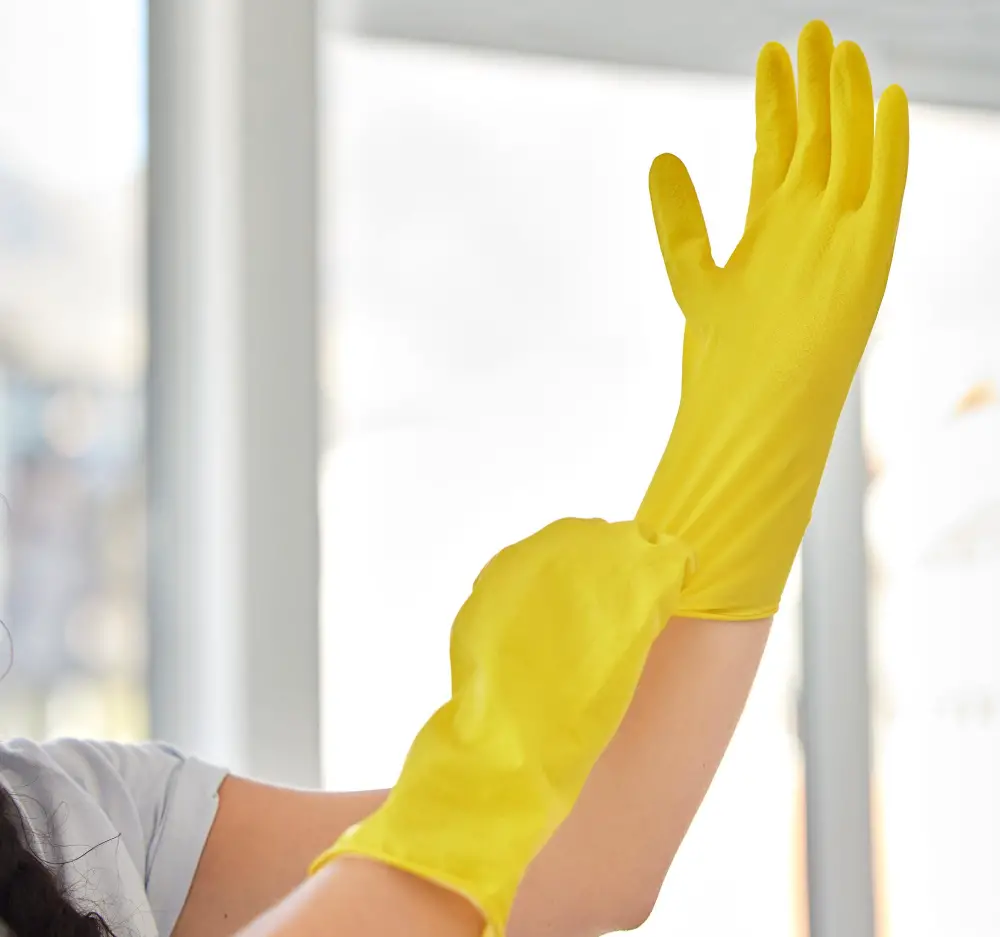
This is where gloves come in handy! Put on a pair of rubber gloves and rub them over the surface of your cushions. The static electricity created by rubbing will attract any remaining hair or dust to the surface, making it easy to wipe away with a damp cloth.
If you have pets at home, this step is especially important as their fur can easily get trapped in between fibers. By removing pet hair regularly from your couch cushions, you’ll not only keep them looking clean but also prevent allergies caused by pet dander.
Check for Stains

Stains can be caused by spills, pet accidents or everyday use. It’s important to identify and treat them before they become permanent.
To check for stains on your non-removable couch cushions, start by examining each cushion carefully in a well-lit area. Look out for any discoloration or spots that stand out from the rest of the fabric.
If you spot a stain on your cushion, take note of its location and size so that you can treat it effectively later on. Remember not to rub or scrub at the stain as this may cause it to spread further into the fabric fibers.
Treat Any Stains
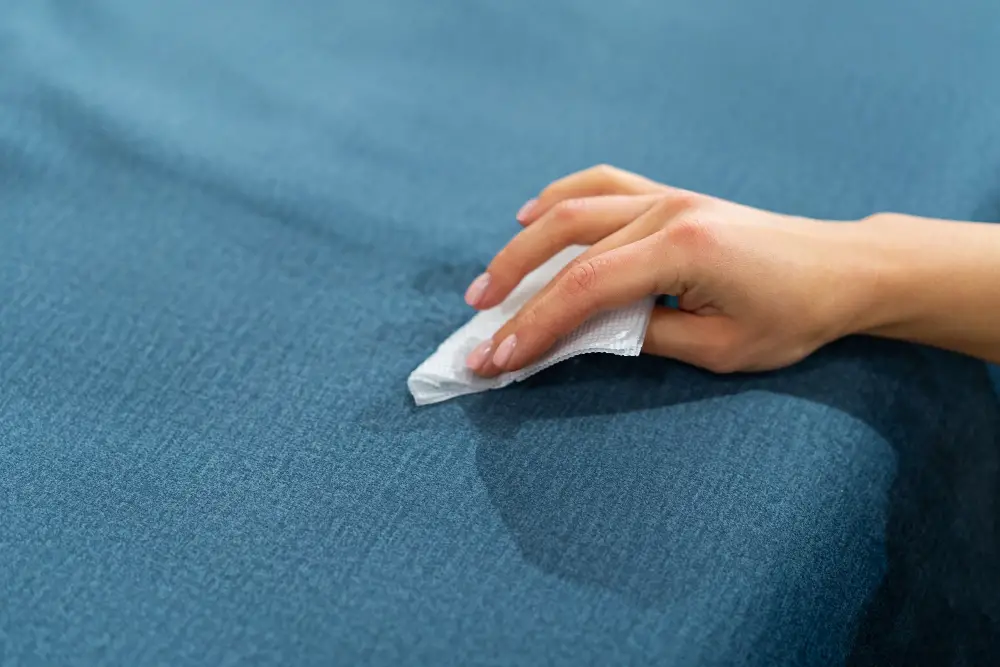
If left untreated, stains can set in and become more challenging to remove.
To treat a stain on your non-removable couch cushion, use a clean cloth or paper towel to blot the area gently. Avoid rubbing the stain as this can spread it further into the fabric.
Next, identify what type of stain you’re dealing with so that you can choose an appropriate treatment method. For example:
- Water-based stains: These include coffee spills or juice marks.
- Oil-based stains: These include grease spots from food or makeup.
- Protein-based stains: These include bloodstains.
Once you’ve identified the type of stain on your cushion, look for specific treatments that work best for each one. You may need different products depending on whether it’s water-, oil-, or protein-based.
Prepare Stain Remover
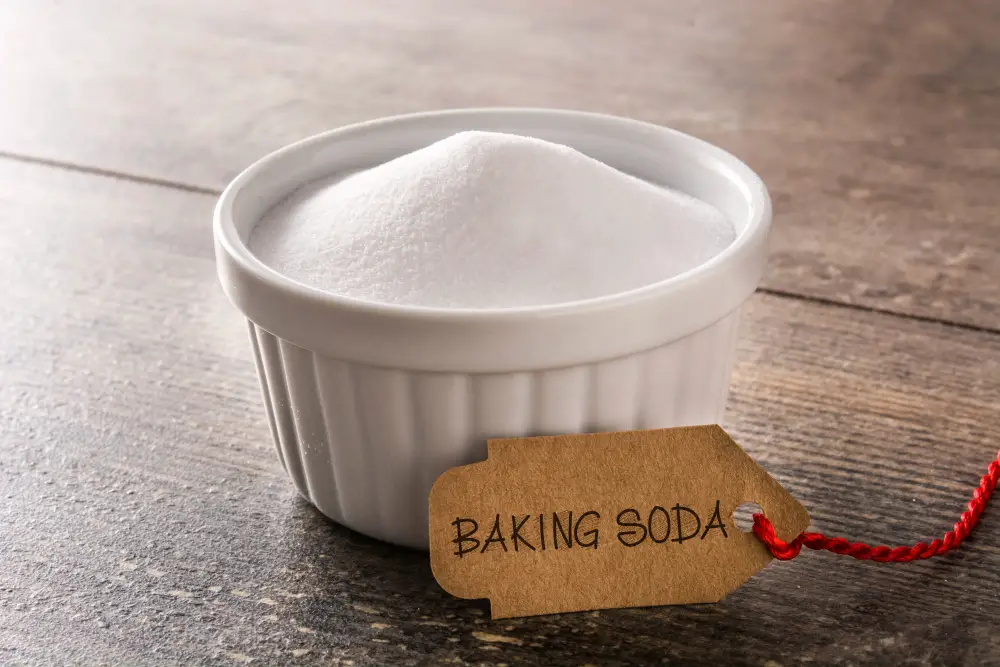
The type of stain remover you use will depend on the type of stain and cushion material. For example, if your cushion is made from delicate fabric such as silk or wool, avoid using harsh chemicals that can damage the fibers.
For general stains like food spills or dirt marks, mix one tablespoon of dish soap with two cups of warm water in a bowl. Stir until suds form and apply this solution to the stained area using a clean cloth.
For tougher stains like ink or bloodstains, make a paste by mixing baking soda with water until it forms into thick consistency then apply this mixture directly onto the affected area.
Apply Stain Treatment
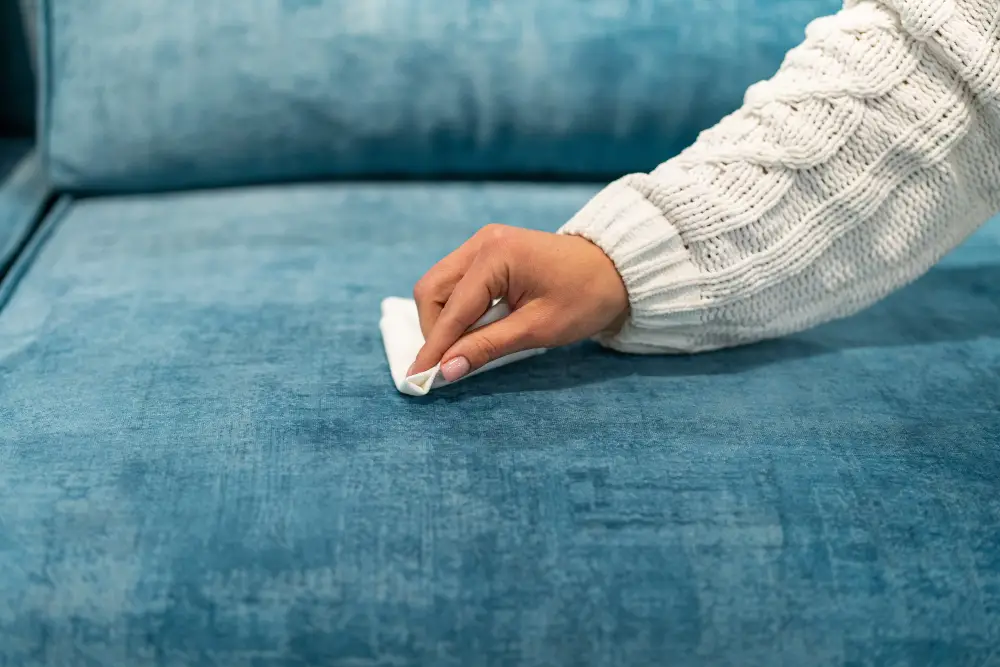
There are many different types of stain treatments available, so be sure to choose one that is appropriate for the type of stain and cushion material.
Before applying any treatment, test it on an inconspicuous area first to ensure that it won’t damage or discolor the fabric. Once you’ve determined that the treatment is safe to use, apply a small amount directly onto the stained area.
Use a clean cloth or sponge and gently blot at the stain until it begins to lift away from the fabric. Avoid rubbing too hard as this can cause further damage or spread the stain around.
Mix Cleaning Solution

The right cleaning solution will depend on the type of fabric and stain you are dealing with. For general dirt and grime, a mixture of warm water and mild dish soap can do wonders.
To make this simple yet effective cleaning solution, fill up a bucket or bowl with warm water (not hot) and add in one tablespoon of mild dish soap. Mix well until suds form.
If your couch cushion has tough stains like ink or wine spills, then consider adding white vinegar to the mix instead of using only soapy water. In such cases use 1/4 cup white vinegar mixed into two cups lukewarm water along with one tablespoon liquid detergent for best results.
Remember that different fabrics require different types of cleaners; always read care instructions before mixing any solutions as some materials may be sensitive to certain chemicals which could cause damage if used improperly.
Test Cleaning Solution
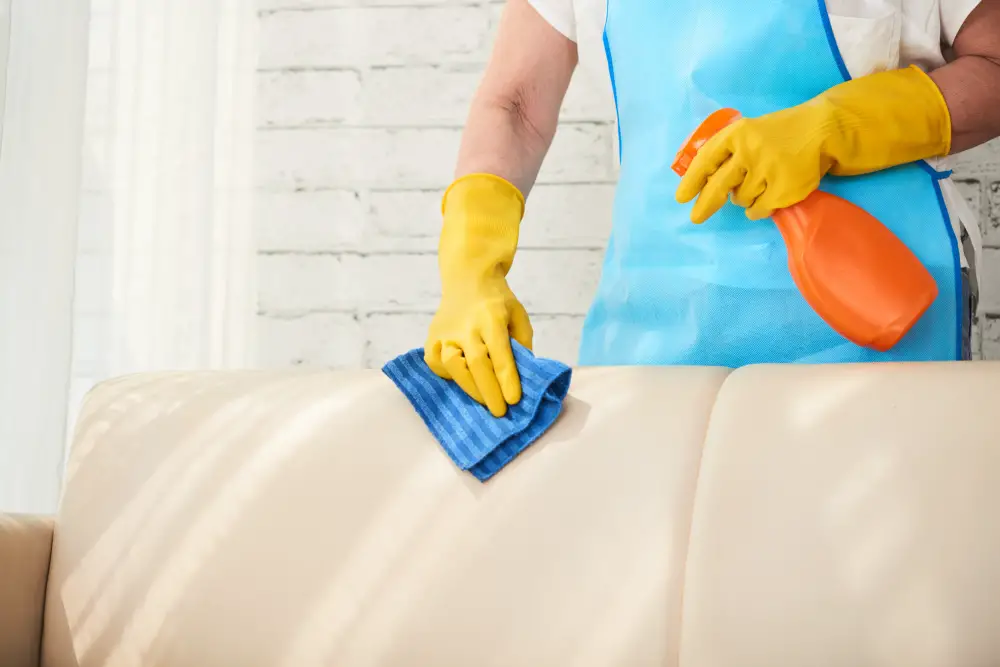
Testing the cleaning solution will help you determine whether or not it is safe for your cushion material and prevent any damage that may occur during the cleaning process.
To test a cleaning solution, apply a small amount of the mixture on an inconspicuous area of your couch cushion. This could be under the seat or at the back where no one can see if there are damages caused by testing.
After applying, wait for about 10-15 minutes before checking if there are any adverse reactions such as discoloration or fabric damage. If everything looks good after this time frame has passed, then you can proceed with using that particular cleaner on all parts of your non-removable couch cushions.
How to Spot Clean Non-Removable Cushion Covers
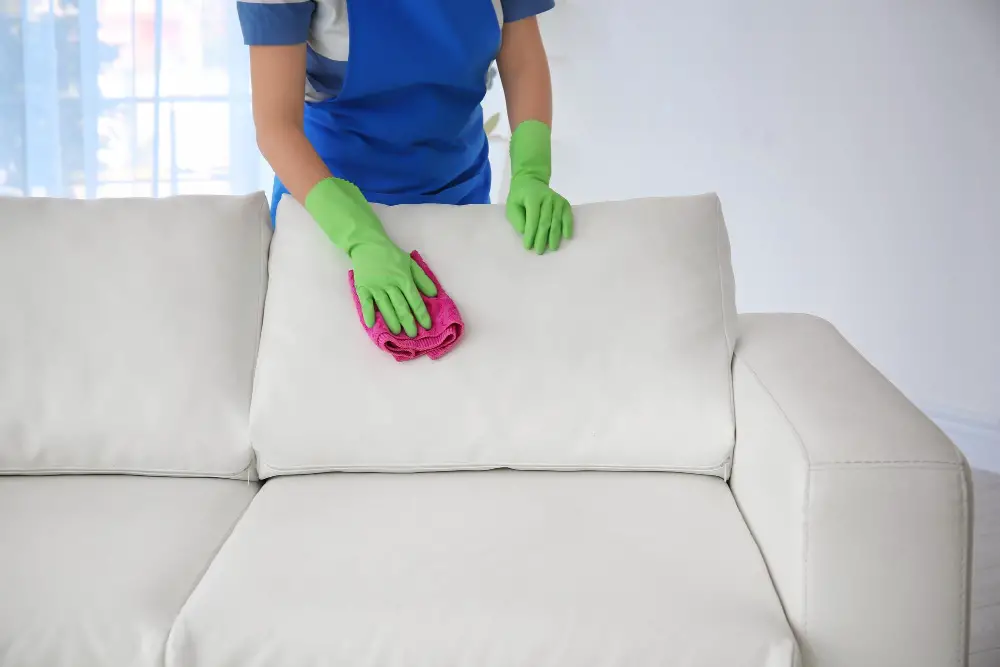
Spot cleaning is an effective way to remove stains without having to wash the entire cushion. To spot clean, start by blotting up any excess liquid with a clean cloth or paper towel.
Then, mix a small amount of mild detergent with water and apply it directly to the stained area using a soft-bristled brush.
Gently scrub the stain in circular motions until it begins to lift from the fabric. Be careful not to oversaturate the area as this can cause damage and prolong drying time.
Once you’ve removed as much of the stain as possible, rinse out your brush and use it again with plain water to remove any remaining soap residue from your cushions.
Use another clean cloth or paper towel to blot away excess moisture before allowing your cushions ample time for air-drying completely before reassembling them back onto your couch.
Cleaning With Water-Based Cleaning Products

First, make sure that your cushions can be cleaned with water. Check the care instructions or test a small area first before proceeding.
To clean your non-removable couch cushions using water-based cleaning products, start by mixing warm water and mild dish soap in a bucket. Dip a soft-bristled brush into the solution and gently scrub the cushion surface in circular motions.
Be careful not to oversaturate the cushion as this can lead to mold growth or damage over time. Once you have thoroughly cleaned all areas of the cushion, rinse it off with clean water using a damp cloth or sponge.
Allow your cushions ample time for air-drying before placing them back on your couch frame. You may also want to fluff up any flattened areas once they’re dry for optimal comfort.
Cleaning With Solvent-Based Cleaning Products
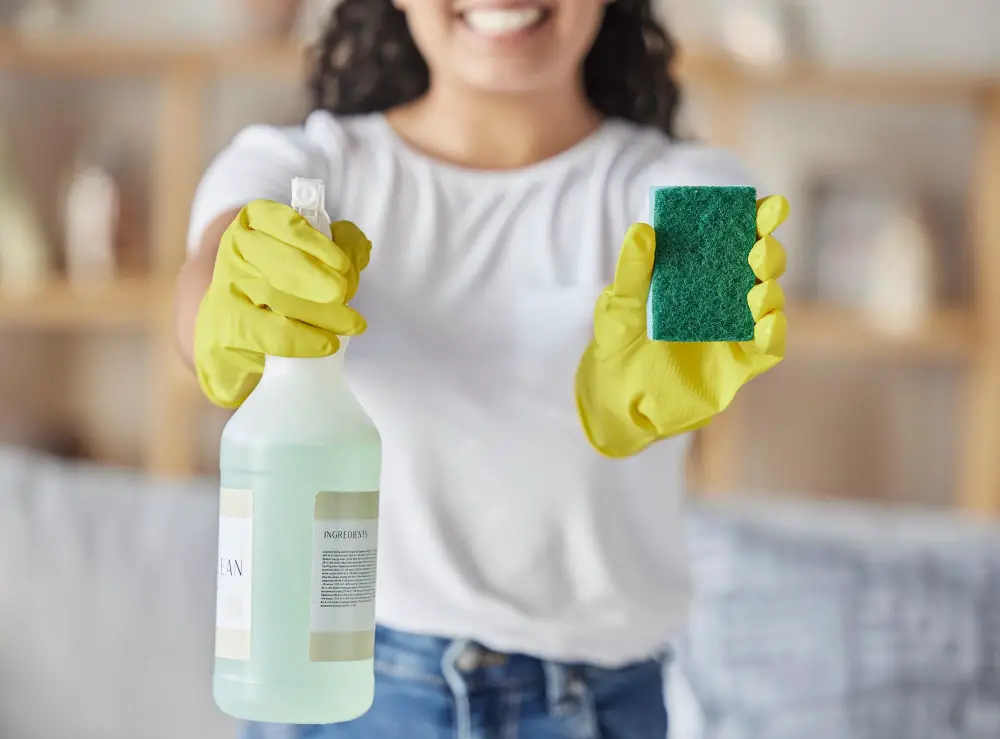
These types of cleaners are designed to break down and dissolve stubborn dirt and stains that water-based cleaners may not be able to remove.
Before using any solvent-based cleaner, it’s important to test it on an inconspicuous area of the cushion first. This will help ensure that the cleaner won’t cause discoloration or damage to the fabric.
When applying a solvent-based cleaner, always follow the manufacturer’s instructions carefully. Be sure to work in a well-ventilated area and wear gloves for protection.
Apply the cleaning solution sparingly with a clean cloth or sponge, being careful not to saturate the cushion too much as this can lead to over-wetting and potential damage. Blot gently until all traces of dirt have been removed before allowing your cushions ample time for drying completely before reassembling them back onto your couch.
Cleaning With Steam

It uses high-pressure steam to penetrate deep into the fabric, killing bacteria and removing dirt and stains. To use a steam cleaner on your couch cushions, first vacuum them thoroughly to remove any loose debris.
Next, fill the steam cleaner with water according to the manufacturer’s instructions. Turn it on and wait for it to heat up before starting.
Hold the nozzle of the steamer about 6 inches away from your cushion surface while pressing down on its trigger button or lever continuously as you move across each section of fabric slowly in overlapping strokes until all areas are covered evenly.
Be sure not to over-wet any area as this can cause damage or discoloration over time due mainly because most fabrics aren’t designed for excessive moisture exposure.
Disinfect Cushions With Hydrogen Peroxide
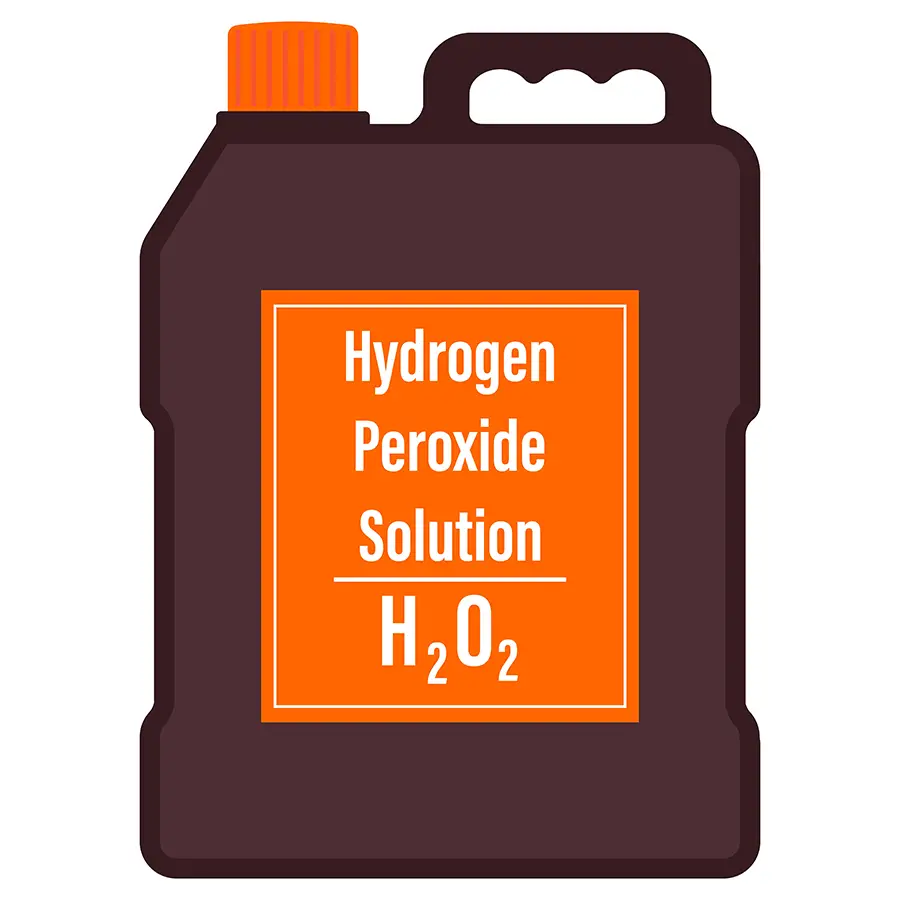
It’s safe to use on most fabrics and won’t leave any harmful residue behind.
To disinfect your non-removable couch cushions with hydrogen peroxide, start by mixing equal parts of water and 3% hydrogen peroxide in a spray bottle. Spray the solution onto the cushion surface until it’s damp but not soaking wet.
Allow the solution to sit on the cushion for at least five minutes before wiping it away with a clean cloth or paper towel. Be sure to rinse thoroughly afterward using plain water.
Hydrogen peroxide can also help remove stubborn stains from your couch cushions while simultaneously killing bacteria and viruses that may be lurking within them. However, always test this method first in an inconspicuous area before applying it more broadly across all of your non-removable sofa pillows.
Deodorize
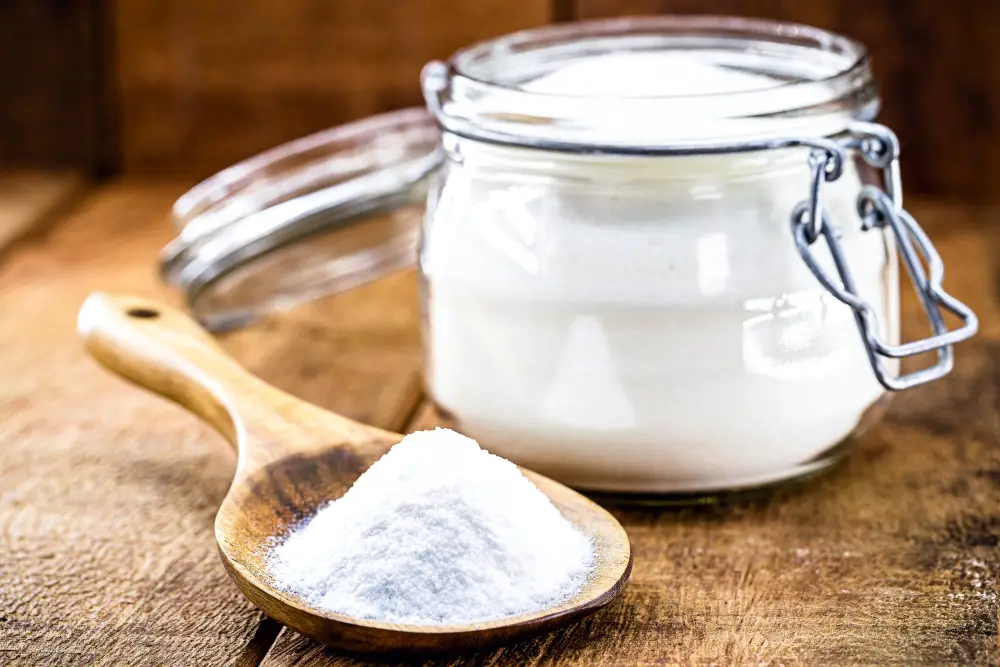
You can use baking soda or a fabric freshener spray for this purpose. Sprinkle baking soda over the cushions and let it sit for at least 15 minutes before vacuuming it off with an upholstery attachment.
Alternatively, you can use a fabric freshener spray by lightly misting the cushions from about six inches away and allowing them to air dry completely.
By following these simple steps, you’ll be able to clean and deodorize your non-removable couch cushions effectively without having to remove them from their covers.
Dry Cushions Thoroughly

Damp cushions can lead to mold and mildew growth, which is not only unsightly but also unhealthy. To ensure that your cushions are completely dry before putting them back on the couch, use a clean towel or cloth to blot up any excess moisture.
Next, place the cushion in a well-ventilated area with plenty of airflow. You can prop it up against a wall or lay it flat on an elevated surface like a drying rack or table.
If possible, position fans around the cushion to speed up the drying process.
It’s important not to rush this step as dampness left behind could cause unpleasant odors and even damage your furniture over time if left unchecked.
Reassemble the Couch

Start by making sure that the cushions are completely dry before placing them back on the sofa. If they’re still damp, leave them out to air-dry for a few more hours.
Next, carefully place each cushion back in its original position on the couch. Make sure that they fit snugly and securely into place.
If you removed any decorative pillows or throws during cleaning, now is also a good time to put those back in their proper places.
Maintain Cleanliness
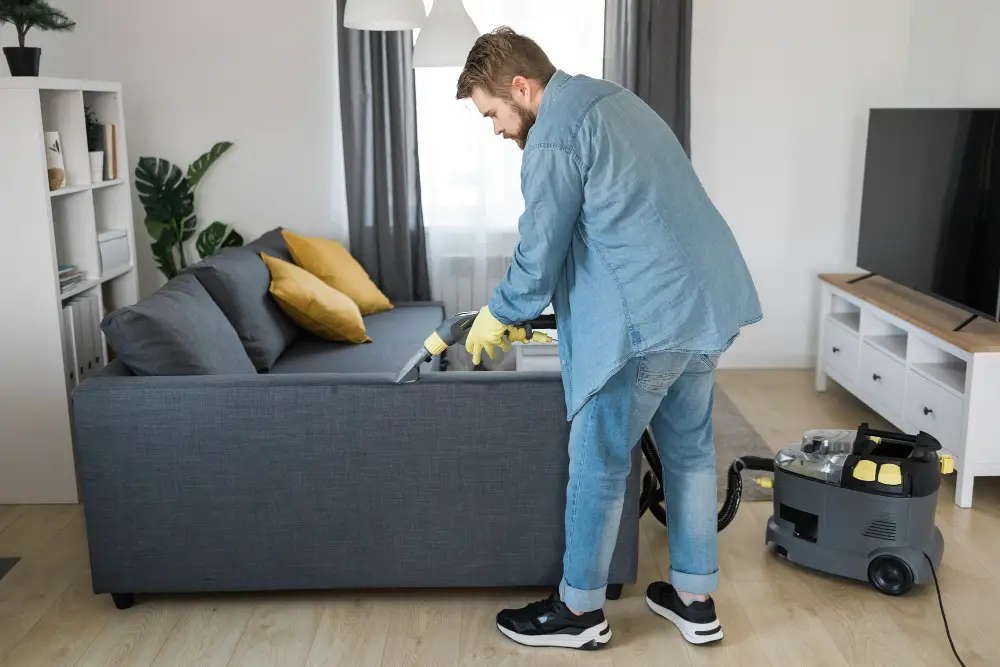
Regular maintenance will help prevent dirt and stains from building up, making future cleaning much easier.
To keep your couch cushions clean, start by vacuuming them regularly with a soft brush attachment. This will remove any loose dirt or debris that may have accumulated since the last cleaning.
If you notice any spills or stains on the cushions, treat them immediately using the methods outlined in this article. The longer a stain sits on fabric fibers, the harder it is to remove.
Consider investing in slipcovers for your non-removable couch cushions. Slipcovers can be easily removed and washed separately from the rest of your furniture upholstery when needed.
By following these simple steps for maintaining cleanliness of your non-removable couch cushion covers after washing them thoroughly as described above; you’ll ensure that they stay fresh and cozy for years to come!
FAQ
How do you clean seat cushions that Cannot be removed?
To clean non-removable seat cushions, use a sponge or soft-bristled brush dipped in a solution of lukewarm water and mild upholstery shampoo, then rinse with clean water.
Can you put couch cushions in the washer?
Yes, you can wash couch cushion covers in the washer on a cold, delicate cycle with dye-free detergent or pod, but ensure they are zipped and avoid machine drying.
How do you deep clean a couch cushion?
To deep clean a couch cushion, mix a solution of 10 parts warm water and 1 part distilled white vinegar in a spray bottle, add a few drops of mild dish detergent, lightly spray the entire sofa after testing, and gently blot with a dry microfiber cloth.
What are the best cleaning solutions for non-removable couch cushions?
Best cleaning solutions for non-removable couch cushions are mild fabric cleaner, homemade vinegar solution, and steam cleaning.
How can you safely spot-clean and deodorize permanently attached couch cushions?
To safely spot-clean and deodorize permanently attached couch cushions, you should gently blot stains using a mild detergent solution, then sprinkle baking soda on the area and vacuum after allowing it to sit for 15-30 minutes.
Are there professional services that specialize in cleaning non-detachable couch cushions?
Yes, there are professional services that specialize in cleaning non-detachable couch cushions.
You may also like to read:
